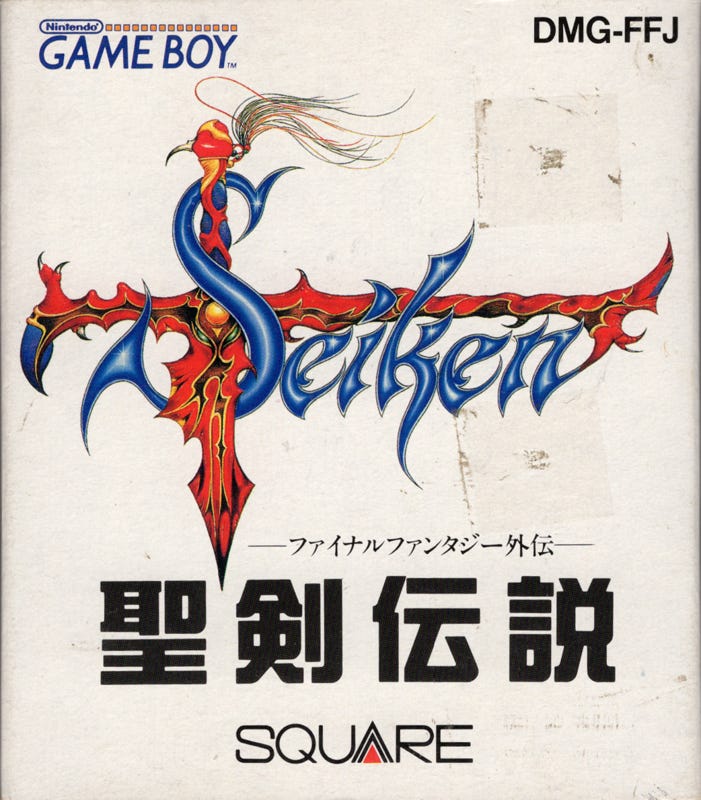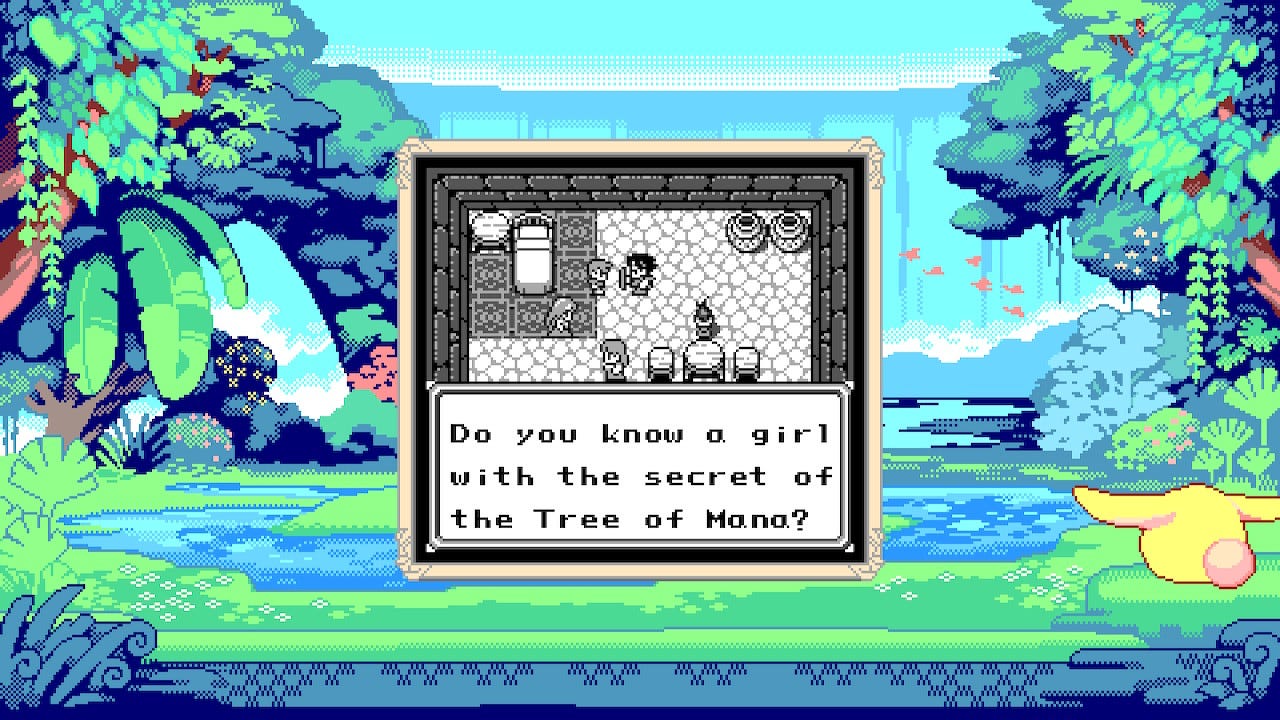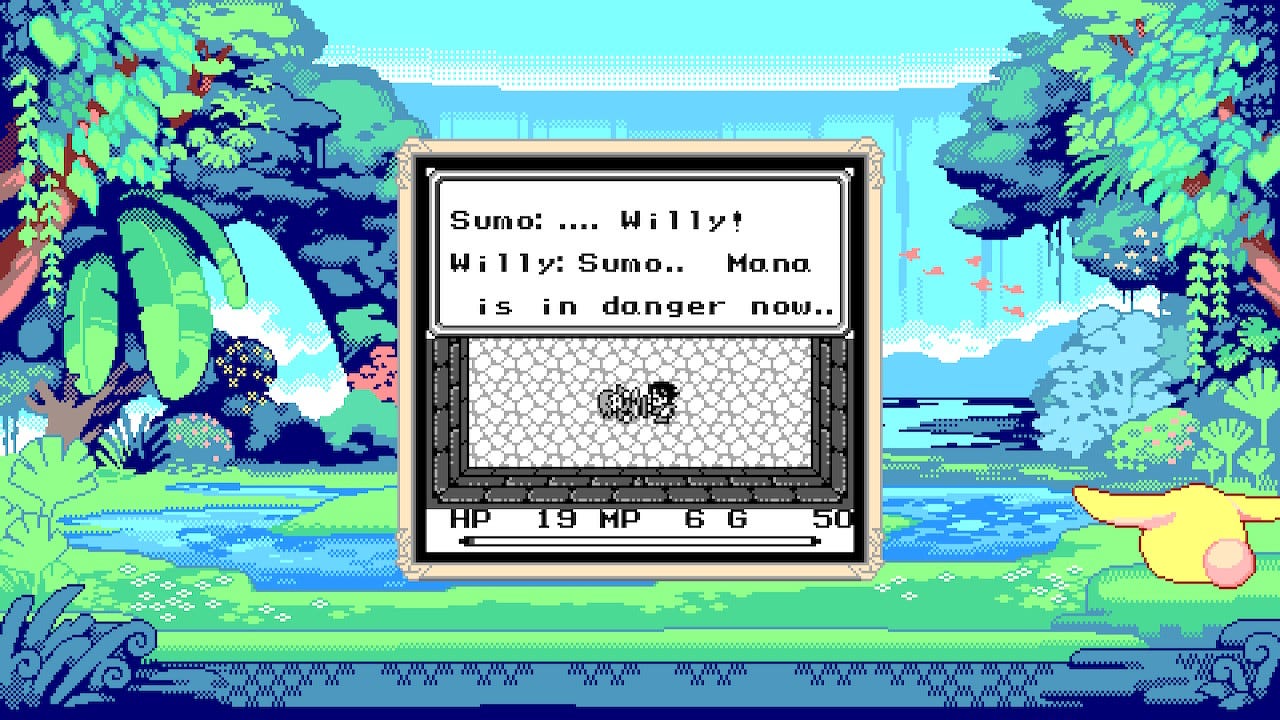Past meets present: Final Fantasy Adventure
Alternatively known as Seiken Densetsu: Final Fantasy Gaiden, or Mystic Quest — no, not that one — or simply just the start of the long-running Mana series.
This column is “Past meets present,” the aim of which is to look back at game franchises and games that are in the news and topical again thanks to a sequel, a remaster, a re-release, and so on. Previous entries in this series can be found through this link.
Way back in June of 1991, Final Fantasy wasn’t quite the sensation we know it as today. It’s not that it was unsuccessful at that point, but three games in, it was still clearly in second place behind Enix and Chunsoft’s Dragon Quest. It was, however, significant enough to have a spin-off that wasn’t really all that Final Fantasy-like at all, and yet could benefit, from a marketing perspective, from the tie-in. That’s Final Fantasy Adventure, or, as it was known in Japan, Seiken Densetsu: Final Fantasy Gaiden.
Rather than a turn-based affair, Final Fantasy Gaiden/Adventure was an action RPG. And rather than Hironobu Sakaguchi, the director of Final Fantasies 1-3 (as well as IV and V), it was Koichi Ishii at the helm. Ishii had worked on Final Fantasy games to that point, but often on the graphics and art side, which led to the creation of well-known Final Fantasy staples like chocobos and moogles — this director role for Seiken Densetsu was his first such opportunity.
Ishii had apparently wanted to make an action RPG ever since he first joined Square, which he himself explained in the liner notes for the Seiken Densetsu OST. “Since I joined Square, making an action RPG had been a big dream of mine. I’m really happy I got that chance in the form of Seiken Densetsu. I gathered an extremely talented team together, and Square gave me the freedom to do as I wished with the game.” Ishii did put a team together, but he’s also credited as not just the director, but the artist and one of the game’s writers, too, with the other being Yoshinori Kitase, the director of Final Fantasy VI, Chrono Trigger, Final Fantasy VII, Final Fantasy VIII, and Final Fantasy X, who remains with Square Enix to this day. It was the first solo project for composer Kenji Ito, who would continue to compose for Mana games as well as the SaGa series for Square, and whose work has appeared in everything from the Culdcept to Smash Bros. franchises.

There are a whole bunch of names that would become well-known that were central to Final Fantasy Adventure, is the point. And they did it without utilizing much in the way of Final Fantasy outside of the name (and the appearance of a temporary chocobo ally).
Seiken Densetsu is the Japanese name for the Mana series of video games. While future entries would get the Mana branding, this first one did rely on a Final Fantasy association, even in Japan, where it was a “gaiden,” aka “side story,” title. This first game in the Mana series, though, is also a bit different from the other Mana titles. You have companions, but they’re temporary ones and aren’t controlled by you — there’s no co-op, like in the beloved sequel for the SNES, Secret of Mana. These companions don’t even necessarily attack enemies alongside you, and in some cases just kind of mull about, but they all have a purpose, be it narrative or for an actual assist in gameplay.
As a proof of concept, though, well, it’s pretty easy to see how this ended up spawning its own series. Final Fantasy Adventure asked the question, “What if The Legend of Zelda were an action RPG instead of an action-adventure game?” and managed to come up with a satisfying answer that’s still fun decades later. It’s not a Zelda clone by any means, but it has more in common with the design of The Legend of Zelda than it does with, say, Ys I & II. The closest comparison on the action RPG side is maybe SNK’s Crystalis, but even that’s not quite right: just like that game, Final Fantasy Adventure drew some obvious inspirations, especially in terms of how dungeons should be structured and solved, but it’s very much its own thing.
So, you go around this big map that you can open up more of as you progress thanks to acquiring new items or partnering with characters who will help you in one way or another. You earn experience points by defeating enemies, and must keep your equipment updated in order to deal and receive appropriate damage. You visit towns, speak with NPCs, control the growth rates of your character, but also amass a bag full of items and a book full of spells to help you both fight and survive and progress. The action-adventure elements are obvious, but even more obvious are the action RPG ones, so it lands squarely there even if it’s most significant inspiration (including, pretty regularly, visually speaking) is from another genre.

Combat itself in Final Fantasy Adventure is unremarkable, in the sense that it’s not doing anything new and exciting: see enemy, attack enemy. It does combine elements of other games together into an enjoyable system, however. You have a meter that charges up over time in between button presses, and it unleashes a powerful attack exclusive to that weapon type when full. It decides to forego the question of which is the right way to wield a weapon in a topdown action RPG or action-adventure game — slashing or stabbing? — by letting you do both. Which is a satisfying way to go about things, really: Golvellius is great, for instance, but feels built more for slashing than what it went with, and as excellent as Crystalis is, you definitely feel the lack of range the stabbing allows. In Final Fantasy Adventure, you default to a wider slashing like in The Legend of Zelda, which gives you room to attack enemies without it always being head-on, but if you press one of the cardinal directions while you press the A button, you’ll instead stab in that direction with the sword. It’s a little thing in some ways, but it helps a lot with the combat flow state, and that matters for something where combat is as simplistic as it is here. And it’s a bit of a surprise considering that not all weapons can even take advantage of the versatility of a sword, and yet, the system is here all the same.

Like with Crystalis, you’ve got more actions you can perform than buttons to perform them with, though this time it’s due to the Game Boy’s limited button set rather than that of the NES. The A button is always for your primary weapon, whether that’s a sword, axe, chain, whatever. The B button is for whatever item you’ve decided to hold, whether it’s a tool or something to heal yourself with, or for the spells you might want to cast. You can’t have both a spell and an item equipped at the same time, which means you’ll be in your menus equipping and unequipping pretty regularly, but at least these trips to the menu pause the action on screen.
Items are fairly typical, with different levels of hit point-restoring cures, or ways to recover from status effects. On occasion you’ll pick up a gem or bag of gold you can sell at a shop, which you might not always need, but if you end up being a big spender for items early or don’t spend enough time in combat earning cash, it can help. There are some oddities, too: you can acquire mattocks to break through rocks, but they are limited in their use, so you need to make sure you always have a backup, and you have to purchase packs of keys, which work for any door you come to unless it’s closed for story purposes. There’s even one spot in the game where you can accidentally lock yourself out because the door requires a new key every time you go back through it, and this area is self-contained: if you can’t get back to the in-house key shop in this castle because you’re out of keys, well. You better hope your previous save data can help. Just make sure you keep a healthy supply of keys on hand.
You’ll have room in your inventory by the time this part of the game rolls around, anyway, as items do become a bit redundant as you learn more spells. As long as you have ethers to restore your magic points, you can keep on healing yourself or getting rid of your negative status effects, without having to keep a stock of antidotes and cures and the like for any possible thing that could happen to you. Plus, you eventually get weapons that can do the job of a mattock, which ends the need to clog up your inventory with those: these two evolutions of your inventory allow you to keep magical spells equipped longer, too, since there’s less need to switch back and forth to make everything work.
You have a bit of freedom in what you want to make your character excel at. Each level brings with it some guaranteed stat growth, but you can work on becoming singularly focused in one area or another, or exceptionally well-rounded, or whatever you want, by choosing which of the stats to emphasize by placing an extra point there. There are just the four stat categories, so the differences can only be so great, but still. You have Power, Wisdom, Stamina, and Will to choose from: Power is for attack, Wisdom for effectiveness of spells and your magic point pool, Stamina for hit points, and Will controls how quickly your special attack meter will refill. The growth patterns do impact each other, too. Let’s say you pick Power to enhance your attack that much more. Stamina and Will will both receive a boost in growth (though not as significant as Power’s), while Wisdom will see the least amount of growth that level. It also works in the opposite direction. Which means you can grow pretty strong and well-rounded just by switching back and forth between Power and Wisdom each level, gaining Stamina and Will along the way, or you can decide to go all-in on magic and spend the game setting foes on fire instead of swinging weapons at them, or become a melee weapon guy with little use for your spells. The world’s your oyster and all that.
While you do often travel with a partner, they’re controlled by the game itself, and mostly just mill about occasionally attacking enemies or, in the case of some non-attacking partners, just doing the milling about part. Many of them have special skills they can use if you select the “Ask” command from the menu: the unnamed young woman you meet early in the game can use a regenerative healing spell on you, a red mage you meet later can point out whether there are secret walls to destroy in the room you’re in, the chocobo can be ridden to both move faster and avoid enemies. There are eight of these “guest” characters, and they also include an old knight, a bard, and a robot, so you’ll get quite your fill of archetypes. Upon departure, they’ll often provide you with a spell, or item, or advice, or allow you to progress to a new area somehow.

Final Fantasy Adventure mostly holds up to this day, over three decades later, as even with its simplicity and being on an 8-bit handheld there’s plenty to like here, and an easy understanding of how it launched a series. The relative sparseness of its story doesn’t actually hurt it at all. The game begins with your character (you can name them, but the default from the manual is Sumo), trapped within a coliseum as a gladiator. You escape, you overhear an evil plot, learn about the Tree of Mana, end up pushed off a cliff, survive, bump into a young woman of legend, and then various events compel you to keep going forward, taking up someone else’s quest as your own to see it through. It’s not unenjoyable as far as tales go, it’s just the kind of story that makes an appearance when it has to, and otherwise leaves you to fighting your fights and exploring. And it all works here.
There are some complaints to make with Final Fantasy Adventure, though: it does go on just a little bit longer than it should, especially since it makes you feel as if you’re coming up on a conclusion only to put the actual conclusion well beyond that moment, and with that happening at a time where you’d be plenty happy if the game ended there. This is a small concern, at least, and it has more to do with some pacing than actual length, as you can complete this one in a day if you zero in on it. The game remains enjoyable beyond that, it just maybe needed to be a little bit tighter in its grander narrative to wrap things up at the speed that the action RPGs of the day often did.
That all being said, this is a game I remember enjoying on an actual Game Boy back in the early 90s, and it was still a good time all these years later in the Collection of Mana, which is available physically and digitally for the Nintendo Switch. It includes not just Final Fantasy Adventure, but also Secret of Mana and the Playstation version of Trials of Mana. You can change the screen resolution, what’s in the letterboxed backgrounds, and even put some tint filters on the screen so that it can be played with the black and white they were made with, the green they were presented through, or a more Super Game Boy-style sandy/tan tint that at least keeps you from staring at black and white or that green if you don’t care for either. There aren’t any options for scanlines, though, and the controls are the controls, without any of the kind of remapping that Digital Eclipse’s excellent re-release of Crystalis allowed for, so it still feels, for better or worse, just like it did in 1991 on original hardware.
Still, it’s an enjoyable ride, and there are plenty out there who believe this initial version of the game remains the best of them, rather than either of the remakes — Sword of Mana on the Game Boy Advance is practically its own game that borrowed elements from the original and was not well received for the changes it made, while Adventures of Mana hewed more closely to Final Fantasy Adventure, only this time in 3D. Which can add or detract from the charm, depending on what you’re looking at, but regardless, it was at least received more positively than Sword of Mana.
This newsletter is free for anyone to read, but if you’d like to support my ability to continue writing, you can become a Patreon supporter, or donate to my Ko-fi to fund future game coverage at Retro XP.




Yes! I’ve been thinking of replaying Sword of Mana on my Pocket, but maybe I should do the OG instead.